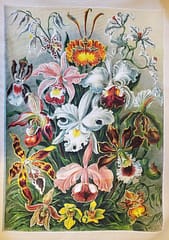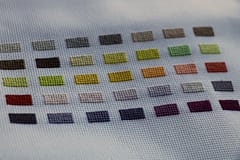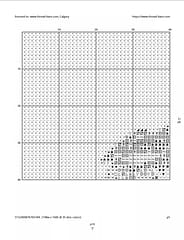The Secret Truth Behind Cross-Stitch Chart Design
Understanding how chart designing works
Contents
Introduction
Ok, the headline maybe a little overhyped - I’ll tell you right now that there’s no alien technology involved (sorry). I know this article might even be a little controversial* but we’ve seen a lot of misleading comments about the process of designing cross-stitch charts and at the same time, there also seems to be a lot of curiosity about the process but not a whole lot of information available to explain it.
At one time, we were a little “in awe” of the charts that people produced and figured there must be some amazing secret process to it all but after working on a cross-stitch pattern making tool which required learning a lot more detail about the process, I feel like Dorothy in The Wizard of Oz … finally seeing the Wizard behind the curtain who’s busy trying to pretend there is more to it all.
So, I’m going to explain some truths about the process to creating great cross-stitch charts and why we need to begin with a clear definition of what “great” really means.
What Makes a Great Pattern?
What makes a great chart? For me it’s two things: something that’s going to look great when it’s been completed … but also, something that can actually be completed - in a lifetime!.
Some people would have you believe that a “great” pattern means big. No, not just big. I mean BIG. Lots of stitches, lots of colors. Impressive eh? Well …
The truth is that creating a good cross-stitch design is about compromise. As I explained in an earlier article about dithering images and how image information is discarded it’s easy to create an amazing looking pattern - just take the photo from any modern high-end multi-mega-pixel camera and make each pixel a stitch, use as many colors as DMC make threads for and boom, you have THE most amazing pattern ever that will look incredible if you, your children, their children and your descendants ever mange to complete it. Make no mistake - they’ll all need to work on it too if it’s ever to be finished:
A photo that is 6,400 x 4,800 pixels would be 30,720,000 stitches. Yes, thats thirty million stitches, and we’re talking complex stitches - a photo typically won’t have lots of solid blocks of single colors that are easy to stitch - it will have lots of confetti to slow you down. Suppose you manage to stitch 500 stitches each and every day without a break that would take 61,440 days or 168 years. Better get those grandkids trained up and hope you still like the picture!
We’re also ignoring the fact that even at a fine 25 stitch-count fabric, that would be a 256” x 192” or 21.5ft x 16ft monster - how big is your wall? Because that would be too large for anything smaller than a large castle! We’re talking Bayeux tapestry scale. You’d be trying to stitch on the equivalent of a huge roll of carpet if you could even buy material that large or you would have alot of extra work trying to sew panels together.
Let’s get real. If we want a photo on the wall, just get a photo printed - it will look great.
Cross-stitching is more “art” like creating a painting - a simplified version of a scene with the illusion of detail that isn’t really there. But our eyes and brains fill in and see the detail and it will still look amazing and impressive.
A great pattern is one that will look good and can be completed. It’s not really an “achievement” to create a huge chart with lots of colors - of course it’s going to look good - the closer you get to the original image, the better it will appear but also as we’ve seen, the more impossible it will be to complete. What is much harder is making a chart that looks good even when the resolution has been reduced and the number of colors have been limited - down to a size that makes it achievable.
But what does “much harder” mean?
How Long Should It Take?
I’ve seen some people state it takes them tens of hours or even multiple weeks working on a chart design and it involves lots of pre-processing to prepare the images in advance. Maybe if we went back in time 20-30 years and wanted to create a photo-realistic pattern it might have taken someone many hours of painstaking effort to map the colors in an images to become stitches in a pattern (and why cross-stitch designs used to be much simpler and flatter than they are today) … but nowadays a computer can do that for us in milliseconds and do it better than a human ever could.
Within minutes, we can load a photo and try out different resolutions and thread counts to get something that looks good and can be completed in a reasonable time.
The reason we’ve decided to limit the maximum pattern size our app creates to a maximum of 1,000 stitches in size and 255 colors is not because it wouldn’t be trivially easy to make both much higher - but rather because we feel it would be misleading and unethical to sell people patterns that we don’t believe they could complete.
It’s important that the piece is achievable because it can be a huge time commitment and if a piece takes too long to complete, it’s easy to become less enamoured with it than when you first picked it.
What’s in style or in vogue changes over time, your own tastes change too or you might simply get bored with the same image after looking at it for several years. So pick an image you love and only make it as large as you can realistically commit time to completing it.
Show Me An Example!
Yes, I know - “words are cheap”. How about we work through an actual example to demonstrate what I mean? We’ll take a large, detailed photo and create a pattern from it … in minutes. No pre-editing of the photo, no other tools required - just the app running in the browser.
I’ll show how the big, detailed, impressive-looking chart is actually the least effort to create, but how easy it is to adjust things so that it becomes “doable” and still looks great.
For this example I’m going to use the super-detailed and sharp Canon EOS 5Ds Sample Portrait Image. It’s an amazing quality 5792 x 8688 / 50 Megapixel image which based on the assumptions earlier would take 275 years to stitch (yikes!)
I encourage you to download the photo from the link above and zoom in to see how detailed it is (and maybe suggest reasons I can give to my wife why I really, really need to be allowed to buy a new camera …)
Here’s a section blow-up showing the level of detail - this part of the image alone is around 1,000 pixels tall:
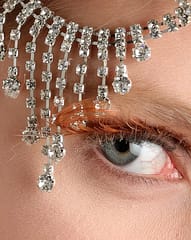
If we try to reproduce the entire image with 1,000 pixels we’ll of course already lose some detail but this is what cross-stitching is all about - creating a representation of the original photo. Here is how that part would look:
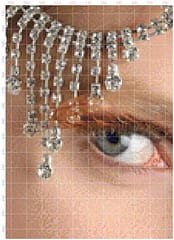
Reducing the size further simplifies the image, here it is again at 620 - being able to adjust the sizes in the app and see the changes immediately makes it quick and easy to try out variations until we find the size we’re happy with:
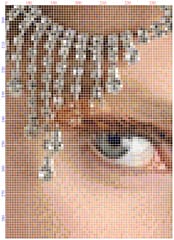
If we want, we can make the pattern even smaller - we’ll obviously lose more detail the smaller it becomes but sometimes a smaller size is the better option if it matches the time we have available and our current skill level.
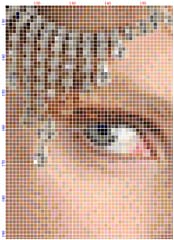
Here’s a video of the complete process showing the easy option of just setting all the inputs to the maximum size which creates an impressive-looking but probably too-challenging chart, then how just a few minutes spent altering the options can create a much more achievable piece that still looks close to the original.
Hopefully that demonstrates that it isn’t really an achievement to just create overly-large patterns that use a excessive number of colors - of course the pattern will “look” good. What is much more impressive is how small and simple you can reduce a chart while still having it produce a great looking piece.
If you want large, detailed and challenging patterns you can of course create them with our tool if you want. But it only takes a few minutes to try different options and generate a chart that you may enjoy working on much more. There’s no magic involved, there’s no need to use additional tools or pre-process images.
We’d love to hear your feedback whether you fundamentally disagree or just want more detail if things aren’t clear - let us know what you think.
*this controversy (and video) was brought to you by the husband part of the Thread-Bare team and the developer behind the pattern-making tool.
Follow our us on our Thread-Bare Stitching Facebook Page or Thread-Bare Stitching Pinterest Channel for news and future articles.


